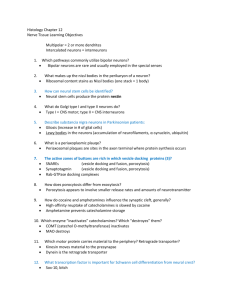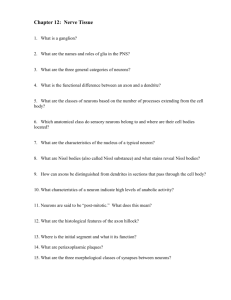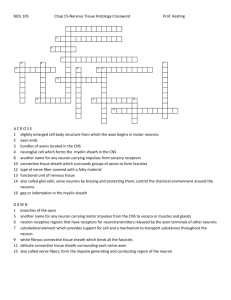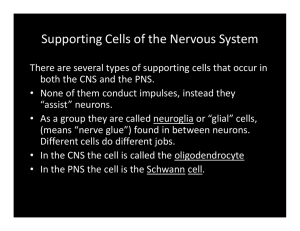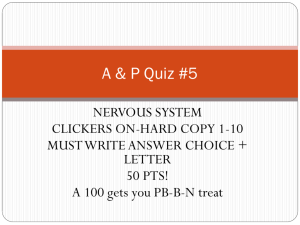Neural cells
advertisement
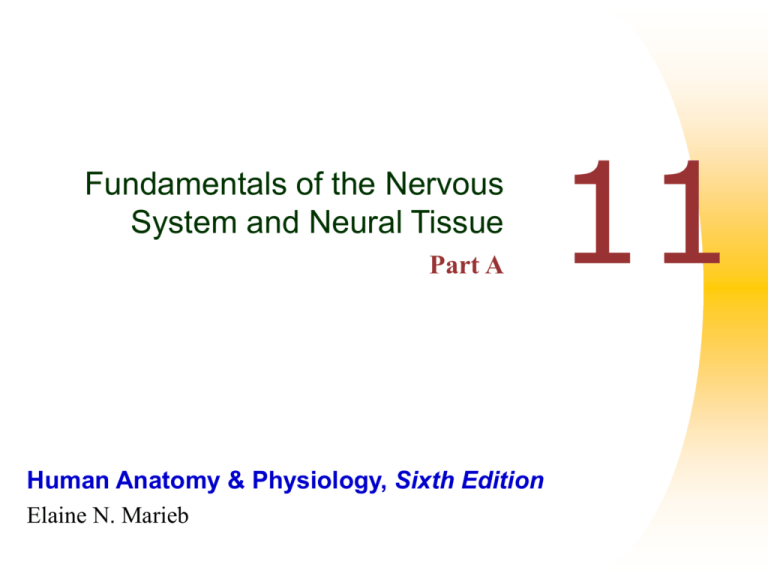
Fundamentals of the Nervous System and Neural Tissue Part A Human Anatomy & Physiology, Sixth Edition Elaine N. Marieb 11 Nervous System Figure 11.1 Divisions of the Nervous System Divisions of the Nervous System CNS PNS Efferent (motor) neurons Sympathetic ANS Parasympathetic Somatic Afferent (sensory) neurons Neuroglia – Supporting Cells Provide scaffolding for neurons Segregate & insulate neurons Guide growing neurons to proper connections Promote health & growth of neurons Cell types Astrocytes Microglial cells Ependymal cells Oligodentrocytes Schwann cells Satellite cells Astrocytes Abundant, versatile, and highly branched CNS cell Cover capillaries Support & brace neurons Anchor neurons to their nutrient supplies Guide migration of young neurons Control the chemical environment Microglial Cells Microglia – small, ovoid cells with spiny processes Phagocytic Monitor health of neurons Ependymal Cells Squamous or columnar cells lining ventricles of brain and spinal cord Oligodendrocytes Branched cells that wrap CNS nerve fibers (axons) Schwann Cells and Satellite Cells Schwann cells surround axons of PNS neurons Satellite cells surround bipolar neuron cell bodies in ganglia Myelin Sheath and Neurilemma Formation Whitish, fatty (protein-lipid), segmented sheath around most long axons sphingomyelin Formed by: Schwann cells in the PNS Oligodendrocytes in CNS Functions to: Protect axons Electrically insulate fibers Increases speed of impulse transmission Myelin Sheath and Neurilemma Formation A Schwann cell: Encloses the axon with its plasma membrane Concentric layers of membrane make up the myelin sheath Neurilemma Nucleus and cytoplasm of a Schwann cell Neurons (Nerve Cells) Functional units of neurons Composed of a body, axon, and dendrites Long-lived, amitotic, and have a high metabolic rate Plasma membrane functions in: Electrical signaling Cell-to-cell signaling during development Axon Function Generate and transmit action potentials Secrete neurotransmitters from termini Intracellular movement along axons Anterograde — toward terminus Retrograde — away from terminus, toward soma Axons of the CNS Both myelinated and unmyelinated fibers are present Myelin sheaths are formed by oligodendrocytes Nodes of Ranvier are widely spaced There is no neurilemma Regions of the Brain and Spinal Cord White matter – dense collections of myelinated fibers Gray matter – mostly soma and unmyelinated fibers Neuron Classification Structural: Multipolar - three or more processes Bipolar - two processes (axon and dendrite) Unipolar - single process diverges into 2 conductive regions Functional: Sensory (afferent) — transmit impulses toward the CNS Motor (efferent) — carry impulses away from the CNS Interneurons (association neurons) — shuttle signals through CNS pathways Structural Classes of Neurons Structural Classes of Neurons Structural Classes of Neurons


